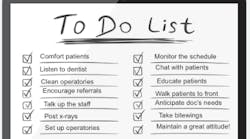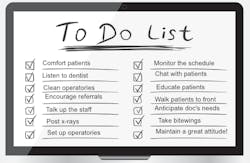THE DUTIES OF CHAIRSIDE ASSISTANTS ARE NOT JUST ASSISTING AND CLEANING INSTRUMENTS. When there are no patients, your time should be used to catch up on cleaning the treatment rooms, tubs, and trays, stocking treatment rooms and burs, organizing stock closets, and more. (Refer to the “Daily Checklist” below.) Treatment rooms should look immaculate at all times. This cannot be emphasized enough.
When patients arrive early, you are to seat them immediately, inform the doctor of the patient’s name and room number, and inform the doctor that the patient is seated. You should inform patients of the estimated time for their appointments and their estimated wait times for the doctor. You should review and update health histories, review the treatment planned for the day and outstanding treatment still to be completed, and ask patients if they have any concerns or questions regarding today’s appointment.
When speaking with patients, you should always promote the office, doctor, and dental hygienist. You can also lead conversations to allow patients to talk about themselves, but you should never talk about your personal problems or situations.
When assisting the doctor, comfort and soothe patients. Some patients want you to hold their hands or just offer some comforting words. It’s a good idea for you to talk with patients to relax them while you’re assisting. To minimize their fear of the unknown, explain to patients what’s being done.
When the doctor directs any questions to you, always acknowledge him or her with an audible “okay.” If you don’t understand, you should ask the doctor to clarify. During treatment, you should follow the doctor with the light. When the doctor asks a patient to move, it is your cue to move the light. Both hands should be used at all times. It’s a good idea for you to always keep a 2x2 of alcohol gauze in your hand to be able to clean the mouth mirror for the doctor.
HERE IS A COMPREHENSIVE "DAILY CHECKLIST" OF DUTIES FOR DENTAL ASSISTANTS. Print it out and place it in the office for referral purposes, and re-read it at least once a month.
• Anticipate the doctor’s needs. If the doctor has to ask you for instruments repeatedly, then you’re not anticipating. If the doctor is instructing the patient to open, then you must also repeat to the patient, “Mrs. Jones, please open.”
• You must keep the bracket tray plus countertop neat and free of debris. All instruments must be placed in an orderly fashion. Be sure this is kept up without sacrificing the doctor’s need for assistance. Always stay ahead of the doctor and ensure patients of your competence.
• When dismissing patients, accompany them to the front of the office and direct them to the accounts manager desk for payment services. Ensure that you have taken the information (i.e., route slip or services rendered form) to the office coordinator prior to walking up the patient. Make sure the front desk staff are able to give patients their undivided attention.
• When appropriate, advise patients that the practice uses the best dental lab and the finest materials, including high quality impression materials, cement, and equipment.
• Again, talk up the doctor and dental office in order to relax patients and encourage referrals. This is all part of your job.
• When patients are dismissed, they must feel that the practice did everything possible to make them comfortable. You cannot be average in this category. You’re an integral part of this function since you spend a lot of time with patients. Ensure patients go over all postoperative instructions and make sure to answer any questions they have.
• When the doctor enters the room, start in this order:
1. Post all x-rays, FMXs, PANs, and BWs on CDR, taking any images or x-rays needed for the appointment.
2. Ensure the appropriate instrumentation is ready for procedure (i.e., restorative trays). Open instrument cassettes and sterilized pouches in front of the patient. Place #12 blade on bard parker and place articulating paper in the holders. Place handpieces on attachments.
3. Review the patient’s health history, noting any changes. Take the patient’s blood pressure.
4. Check on premedication.
5. Place dental napkin (bib) around the patient’s neck and position the chair.
6. Take custom shade, opposing impression, and digital photos.
7. Hand out topical 2x2 gauze pad.
8. Prepare the hand syringe with warm anesthetic.
9. Have additional carpules ready to hand to the doctor if needed.
10. Comfort patients and hold their hands if possible to reassure them.
11. Divert the attention of patients away from the procedure with some interesting conversation.
12. Ask if patients are okay, and if or they would like a bottle of water.
13. Ask if patients want to rinse after their injection.
14. Provide tissue prior to all treatments so patients do not drool on themselves.
15. The doctor should not have to ask you to do these functions. It is your responsibility to be ahead of the doctor.
• When preparing the room, place materials and equipment in the sequence in which the doctor will use them. Then, if anything interrupts you, you can remain several steps ahead.
• When not assisting the doctor directly, be prepared for the next appointed patient. Set up the operatory for the next procedure. Check to see if all staff are caught up in their operatories or if they’re in need of assistance. Keep up with sterilization when you’re not with a patient or the doctor.
• Patients are your number one priority! Stay alert to their expectations regarding appointment length. If you notice you’re going to be running late or finishing early, inform patients so that they can make arrangements if necessary.
• It is your responsibility to monitor the schedule and check up front when patients arrive and seat them immediately. There are very few duties that take priority over this. Being on time is the key to success and happy patients. If a patient is not at the office within five minutes of their appointment time, call them to clarify if they are en route to the office, need assistance with directions, or have had a circumstance that requires a change of appointment time.
• Befriend patients. Ask them about their children, grandchildren, where they’re originally from, vacations, and more. Most people like to talk about themselves.
• You should know a patient’s total treatment, and any questions should be reviewed with the doctor. If your office is not chartless, start organizing the paper charts for a future chartless practice. Purge documents more than seven years old, or scan documents into patients’ charts in your dental software and shred those documents once they’re scanned.
• When asking patients to open, close, rinse, etc., always preface it with please and follow it with thank you.
• When explaining dental problems to patients, be descriptive and educate them through visual props such as models, charts, and pictures. You could even draw a picture for them. You need to get their attention. For example, “A cracked tooth is like a crack in your windshield. It keeps traveling and getting worse,” or, “A cracked tooth is like a crack in the concrete.” Intraoral cameras work great for demonstrations.
• When patients ask about different treatments, say, for example, “I’m not a dentist and only a dentist can diagnose. But if you were my relative I would encourage you to change the filling to a crown.”
• Take BW every six months and FMX (PAN) every three years. Offer patients the option to take a PAN every year. Some patients with comorbidities might want to take more preventive measures and see their problems before they become major. For instance, diabetics can have inflammation and infection that can cause issues with their levels. This can be avoided and treated early with annual panoramic images.
• Offer patients stereo headphones for either the TV or music. Encourage and explain the need for headphones.
• Use protective glasses on all patients. It keeps the bright light and splatters out of their eyes.
• As needed, review home care, especially how to clean under a bridge, implant, or orthodontics.
• As needed, review the use of floss threaders, electric toothbrushes, and water piks.
• Reinforce the need for regular cleanings, whether it’s every two, three, four, or six months. Encourage more frequent recalls!
• If someone’s home care is good, praise them. Contrast the good areas to the bad areas. Regularly maintained patient swithout any breakdown deserve positive reinforcement!
• Use the intraoral camera to demonstrate any abnormalities, such as decay, cracks and fractures, or gum disease. Give possible scenarios if not treated in a timely manner.
• Ask patients if they’re satisfied with the color and shape of their teeth.
• Where indicated, encourage whitening. Use brochures and video and the album of the practice’s before and after photos.
• Ask patients many times during treatment, “Are you doing okay?” Reinforce warm and personal care.
• When the doctor calls you, stop what you’re doing and check with him or her unless you’re seating a patient, trying in a crown, or making a temp.
• Post and read this job description many times each month.
• When dismissing patients, make sure they’re doing well. Wipe their face of any debris. Recommend that they use the bathroom to check their appearance or freshen up. Reinforce preventive homeopathic meds for the next couple days if necessary to minimize postoperative sensitivity or pain.
• Always direct patients to the account manager’s desk so they can take care of any payments.
• Always discuss patients’ next procedures with them. Remember, a completed treatment plan and satisfied patients are top priority.
Remember, you’re an integral part of the success of the dental practice. Perform your many important duties with pride!
Dental assisting requirements, job titles, and allowable functions vary from state to state. Visit the Dental Assisting National Board Inc. website to learn more about state requirements for dental assistants.
For the most current dental assistant headlines, click here.
For the most current dental headlines, click here.
Kevin Tighe, Cambridge Dental Consultants CEO, got bitten hard by the business and marketing bug during long summer days working at his dad's Madison Avenue ad agency. After joining Cambridge as a seminarist in the mid-1990s, Kevin went on to become Cambridge’s senior consultant and eventually CEO. Cambridge Dental Consultants is a full-service dental practice management company offering customized dental office manuals. Frustrated? High overhead? Schedule a chat with Kevin at [email protected].








